Vol 1 No. 14 TROPIC LIGHTNING NEWS June 3, 1966
Index
[The 1966 Vietnam issues of Tropic Lightning News were published in Saigon,
and are of lower quality than later years that were printed in Japan. Over
the years the photographs and text have faded and it has been difficult to
reproduce them. Even when the photos are unclear, I have been included
them to give a sense of the activities in the Division.]
The “Black Panthers” of lst Battalion, 69th Armor, have joined 3rd Brigade at
Pleiku.
The initial elements, Headquarters and Headquarters Company, arrived and
off-loaded at Qui Nhon. From the port, the company headed for a staging area
some 30 miles northwest of Qui Nhon, where they spent two days.
Company C arrived and rendezvoused with the headquarters at the staging
area. Company A followed shortly thereafter. The armor battalion then moved to
the 3rd Bde. base camp at Pleiku.
The unit, reassigned from Cu Chi, where it supported 2nd Brigade, is under
the command of Lieutenant Colonel R. J. Fairfield Jr., who commanded Company A,
of the ‘old’ 89th Armor (forerunner of the 69th) in Korea.
The Bronze Star holder led the battalion in one major operation, “Circle
Pines,” in the Cu Chi area during its three and one-half months there.
Companies and platoons of the battalion were utilized by 2nd Bde. in several
other operations, such as Kahuku Kaena, and Maili.
The 1st of the 69th is the only Army armored battalion thus far committed to
the conflict in Vietnam. It gives the division’s 3rd Bde. a group of tanks and
armored personnel carriers that, if placed side by side and end to end, would
completely blanket a football field.
The more than 500 soldiers of the battalion joined Company B, which had been
separated from its parent unit in February, when it was assigned to the 3rd Bde.
Task Force.
The tank unit will be used in the central highlands, an area of plateaus,
rolling hills and rugged mountains.
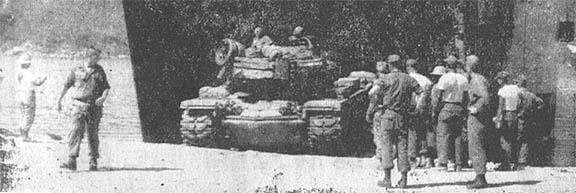 |
| STEEL MONSTERS - A tank from Headquarters Company, 1st Battalion, 69th Armor, off-loads from the gaping jaws of an LST at the Qui Nhon port. The entire armor battalion is now assigned to the 3rd Brigade Task Force. |
157 Viet Cong Die in Wahiawa
First and 2nd Brigades last week terminated operation Wahiawa. The
search-and-destroy mission took the two brigades into the long-time VC base
areas in the Boi Loi Woods and the Filhol Plantation area northwest of Saigon.
The region, birthplace of the National Liberation Front six years ago, was
honey-combed with Viet Cong base areas and supply dumps. Wahiawa marked the
first time American forces had entered some of the densely forested portions of
the area.
As U.S. troops swept the area they were met by stiff opposition from
automatic weapons in dug-in bunkers. A total of 157 Viet Cong were killed in 12
days of fighting. Ten VC were captured and nine suspects were detained.
Quantities of kerosene, paraffin, tar, tin roofing, bar and sheet steel added
to the operation’s totals. A complete dental kit with a foot-driven drill, a
typewriter, a duplicating machine, and almost 5,000 documents ranging from
diaries to tax records also were seized.
More than 855 tons of rice were destroyed or captured by the “Tropic
Lightning” forces. Since the average VC consumes two pounds of rice each day,
the rice would have fed 4,500 men (the equivalent of three VC regiments) for
four months.
Enough cloth was captured to provide one complete uniform to every man in 16
such regiments . . . nearly 100,000 yards. Eight sewing machines also were
captured.
Two tons of medical supplies, enough to treat a VC regiment for several
months, were taken.
Nine VC base camps were destroyed on the operation, including 234 buildings,
41 fortifications and 139 tunnel complexes.
Thirty-one small arms, of Russian, Chinese, East European, French and
American manufacture, were taken from the VC and one heavy weapon, a Czech
anti-tank gun, was captured. A total of 171 mines and other demolitions were
destroyed by division elements. More than 23,000 rounds of small arms
ammunition were captured or destroyed.
Other foodstuffs taken during Wahiawa include 6.5 tons of peanuts. 375 pounds
of salt, almost two tons of dried fish and meat, over four tons of dried beans
and 1.8 tons of sugar.
Viet Cong movement through the area will be hampered until the 41 sampans, 52 bicycles, the motorcycle and the tractor found by the division elements are
replaced.
| Hawaii Named R&R Center Department of Defense officials last week revealed a decision to make Hawaii a rest and recuperation (R and R) center, marking the end of a months-old controversy or the subject. The announcement was made May 24 that the program will be conducted on a trial basis at first, with Vietnam-based servicemen being sent to the Aloha State in an effort to broaden the number of R and R centers now available. Democratic Senator Daniel K. Inouye, of Hawaii, released the news, saying that the Defense Department told him the continued balance-of-payments deficit figured in the decision. Defense Secretary Robert S. McNamara has instructed General William C. Westmoreland, commander, U.S. Military Assistance Command, Vietnam, to begin making arrangements to use Hawaii as an R and R area as soon as possible. |
P.O. Okays Duty-Free Gifts From R&R
Personnel stationed in Vietnam will now be able to mail packages home duty
and tax free from R and R points, postal officials have announced.
Under public Law 89-368, service personnel using the R and R program,
patients, men on TDY or while traveling to or from Vietnam, are authorized to
“mail gifts tax and duty free when not exceeding $50 in retail value in the
country of origin.”
Users of the system must write “P.L. 89-368, Value Less than $50” on the
outside, address side of their package.
The tax and duty free system also applies to items purchased through Pacific
Exchange mail order in Japan from a combat zone. The user must sign the
purchase order attesting to the status of entitlement.
| PINNED - Just a day after assuming command of 2nd Brigade, Colonel Thomas M. Tarpley, of Quincy, Ill., received his eagles from Major General Fred C. Weyand, division commander. Brigade Sergeant Major Marvin Manning, of Richmond, Va., pins the new insignia on Col. Tarpley’s collar. (Photo by Carollo) |
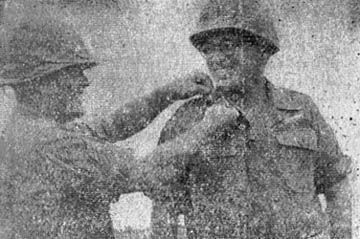 |
Cong Hit Below Belt
“Medic, Medic,” yelled the wounded U.S. soldier as he fell to the ground.
A medical corpsman from C Company, 2nd Battalion, 27th Infantry, crawled out
to give first aid.
“Medic, Medic,” the cry rang again, this time from in front of the first
casualty. Since the platoon medic was busy, a rifleman crawled out to
administer first aid.
Suddenly, the “wounded” man calling for a medic jumped up and opened fire
with an automatic weapon.
“Charlie” had discovered a ruse that veterans of Korea may painfully recall.
Page 2 TROPIC LIGHTNING NEWS June 3, 1966
Decorated
| AIR MEDAL | |
|
2d Lt. Charles H Burgardt, Btry. C, 1/8th Arty. Sp5 Carol Campbell, Co. A, 25th Avn. Bn. Sp4 William A. Easterling, 175th Avn. Co. PFC Ronald D. Homes, 175th Avn. Co. PFC Jerome J. King, 175th Avn. Co. 1st Lt. Walter R. Mace, 175th Avn Co. |
SMaj. Marvin B. Manning, HHC, 2nd Bde. 1st Lt. Robert P. Moore, Co. A, 25th Avn. Bn. PFC Jearld E. Spurlin, 175th Avn. Co. PFC James A. Thomas, 175th Avn. Co. PFC Johnny A. Wilbur, 175th Avn. Co. |
| PURPLE HEART |
|
|
Sp4 William A. Cooper, Co. C, 4/23rd Inf. SSgt. Leslie Crawford, Jr., Co. B, 1/27th Inf. Sp4 Clifford N. Davis, Co. C, 4/23rd Inf. SSgt. Eugene P. Delapena, Co. C, 4/9th Inf. PFC Joseph Eberhardt, Co. C, 1/5th Inf. PFC Ira L. Feinberg, Co. C, 2/14th Inf. Sp4 Ishmael Figueroa, Co. B, 1/5th Inf. Sp4 Daniel R. Gasiewicz, Co. C, 4/23rd Inf. Sgt. Danield I. Lucas, Co. A, 1/5th Inf. SSgt. George B. McClure, Co. C, 4/9th Inf. |
Pvt. Patrick McDermott, Co. A, 4/9th Inf. Sgt. Donald A. Mead, Co. A, 4/23rd Inf. Sp4 James Pflughoeft, Co. C, 1/5th Inf. PFC Melvin Sherrell, Co. B. 1/5th Inf. PFC Harold Stephens, Co. A, 1/5th Inf. SSgt. Daniel Thompson, Jr., Co. B, 1/5th inf. Sp4 Stephen A. Thompson, Co. C, 65th Engr. Bn, SSgt. Ralph Tremblay, Co. B, 1/5th Inf. PFC Larry J. Turner, Co. C, 2/14th Inf. Pvt. Gerald K. Wiggins, Co. C, 4/23rd Inf. |
Reds’ Stunts Result in Split
Roughly 40 years ago, the Communists under Ho Chi Minh, now president of the
Democratic Republic of Vietnam in the north, began planning their campaign to
take over Southeast Asia.
When the Japanese moved in after the fall of France in 1940, dominating the
French and occupying all of Indochina, Communists and nationalists alike
believed that the time for Vietnamese independence was near. Under Communist
leadership and later Communist control, a coalition independence force was
formed. This was the Viet Minh (League for the Independence of Vietnam), which
launched an eight-year struggle against the French soon after they returned in
1945.
Like the later Viet Cong, the Viet Minh grew from a modest start - but they
became larger and much more formidable than the Viet Cong are today. By
mid-1954 the Viet Minh had nearly 160,000 regulars and perhaps an equal number
of militia.
The French, stunned by defeats in conventional battles such as that at Dien
Bien Phu and unable to solve the problems of the new kind of war waged by the
Viet Minh, were ready to negotiate.
At an international conference in Geneva in the summer of 1954, presided over
by representatives of Great Britain and the Soviet Union, war-torn Vietnam was
divided at the 17th parallel. The northern half, controlled by communists,
became the so-called Democratic Republic of Vietnam; the free southern half
became the independent Republic of Vietnam.
Under the terms of the armistice agreement, Communists and anti-Communists
were given an opportunity to move to whichever half of the divided country they
preferred. Nearly a million from the north were able to move south to freedom
during the brief period allowed. Some 90,000 people, mostly men and boys of the
Viet Minh army, or future recruits, went north. Tens of thousands of Communists
and sizeable stocks of arms and ammunition were left in the south to assure an
ultimate Communist takeover.
The 17th parallel was not intended to be a permanent “political or
territorial boundary”. The delegates at Geneva agreed on a “free general
election by secret ballot” to be held throughout Vietnam at the end of two
years. This would allow the people to decide for themselves their political
future, and it would reunify the country.
The Communists, in the more populous north, with their police state control,
were confident of winning that election. The election was not held because the
south doubted the possibility of an honest vote in the north and because the
election would not have been held under proper international supervision.
June 14: Flag Day, 1966
The dictionary describes a flag as “a piece of cloth, commonly bunting, of
varying size, shape, color and device, usually attached by one edge to a staff
or cord, and used as an ensign, standard, symbol, signal, etc.” One cannot
fault the dictionary; the technical accuracy of its definition is above
reproach. But to apply such a definition to the Stars and Stripes would be
utterly futile; it would be to sacrifice the true significance of this “piece of
cloth” on the cold and sterile altar of technical accuracy. The Stars and
Stripes is no more a length of bunting bearing a particular design than the
White House is merely a building of a specific color.
B. J. Cigrand, a perceptive young schoolteacher in Fredonia Township, Wis.,
recognized that the Flag was more than “a piece of cloth,” that it was the
unique symbol of the Nation and all of its accomplishments. He believed that a
special day should be set aside for the citizens of the country to render
particular honor to the Stars and Stripes and to reflect on its significance.
In 1885, on June 14, 108 years after the day Congress had adopted the Flag of
the United States, Cigrand arranged a special program of appropriate ceremonies among his
pupils. He was so pleased with the results of his program, that he determined
to devote himself to the establishment of a national Flag Day.
Ultimately, on Aug. 3, 1949, Congress adopted a joint resolution designating
June 14 as Flag Day. The fulfillment of Cigrand’s appointed mission is not
solely a tribute to his appreciation of the Flag and what it means, it is also a
testimonial to a system of government wherein an obscure but determined citizen
can make his voice heard and heeded in the highest chambers of the land.
Today, American soldiers, sailors, airmen and marines are continuing in the
great tradition of stamping out tyranny. They are against helping those who cry
out for aid in the name of liberty and justice. Our armed forces again are
braving danger and death, standing resolute in Vietnam to keep alive and
untarnished high principles our Flag symbolizes. In planting Old Glory
immovably in the path of Communist aggression, our armed forces are visible,
tangible proof that as long as the Flag endures, “life, liberty and the pursuit
of happiness” is not an empty catch phrase devoid of substance and beyond
achievement. It is the men in uniform who reinforce and revitalize the real
meaning of this piece of cloth.
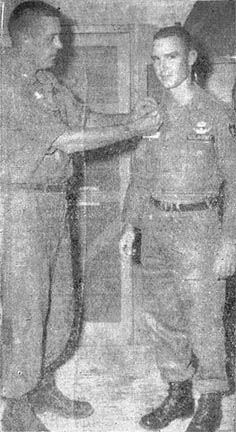 |
ON THE WAY UP - Chief Warrant Officer Ronald B. White, a pilot with Company B, 25th Aviation Battalion, was promoted to his present rank in ceremonies at Cu Chi, by Lieutenant Colonel James Davis, battalion commander. CWO White makes his home in Fayetteville, N.C. (Photo by Vickery) |
V-N Climate Conducive to Heat injury
Heat injuries occur whenever men are exposed to high temperatures. Although
such injuries are usually minor, resulting in cramps or headaches, the more
severe ones can result in prostration, coma or death.
Heat injuries can usually be prevented by gradually increased exposure.
Conversely, new arrivals in-country are those most susceptible to injury when
they are suddenly exposed to high temperatures for a long time.
Clothing greatly affects the heat load on the body. The proper type of
clothing can help prevent heat injury by shielding the body from the direct rays
of the sun, yet allowing ventilation. Tight fitting clothing or unnecessary
equipment should be avoided.
Most everyone has had a case of sunburn. Although a bad burn is usually just
the butt of a few jokes, and a cause for some discomfort, a really serious case
can cause disability and even death. A good tan can usually prevent sunburn but
remember that suntan oils and lotions do not provide complete protection.
Water and salt are most important in avoiding heat injuries. A normal person
should consume at least six quarts of water per day in this climate, even if he
does not feel thirsty. For persons performing heavy physical labor outdoors,
thirteen quarts would not be too much.
The reduction of the body’s water and salt supply puts a strain on body
chemical functions. Normally there is not enough salt in our diets to make up
for the salt lost through perspiration. That necessitates taking salt pills and
taking them regularly. Perhaps you have felt dizzy when rising or your joints
ache at times. These are symptoms of salt deficiency and a sign to beware of
greater heat fatigue.
A physically fit person is able to tolerate high temperatures more than one
who is overweight or has recently been sick. But remember that you cannot
condition yourself to go without water, salt, and the proper kind of clothing,
or “the heat will get to you.”
| The TROPIC LIGHTNING NEWS is an
authorized publication of the 25th Infantry Division. It is published
weekly for all division units in the Republic of Vietnam by the
Information Office, 25th Infantry Division, APO U.S. Forces 96225. Army
News Features, Army Photo Features and Armed Forces Press Service material
are used. Views and opinions expressed are not necessarily those of the
Department of the Army. Printed in Saigon, Vietnam, by Dai Doan Ket
Publishing Company. Maj. Gen. Fred C. Weyand . . . . Commanding General Maj. William C. Shepard . . . . . . Information Officer 2nd Lt. Patrick J. McKeand . . . Officer-in-Charge Sp5 Dale P. Kemery . . . . . . . . . Editor PFC David A. Pierce . . . . . . . . Editorial Assistant |
Page 3 TROPIC LIGHTNING NEWS June 3, 1966
Tenacious Infantrymen Dog Troubled Viet Cong
Patrols through a dense jungle area with a high canopy. Hours of sweating.
Scratches from thorny vines. The plague of insects. It’s all part of the
infantryman’s life.
The GI staggers back from a patrol, dead tired. He flops down and falls
asleep instantly, only to be up again an hour later to stalk back into the hell
of the Boi Loi Woods.
But the Viet Cong pots of gold at the end of that weary rainbow make the
privations worth it. It is in the Boi Loi Woods that division units have found
hundreds of tons of rice, enough medical supplies to treat several battalions
for months, and stores of ammunition and weapons.
Mines, booby traps and continuous sniper fire harass the American forces in
the area. “Dustoffs” (medical evacuation helicopters) are fired upon as they
remove casualties, the VC ignoring the big, red cross on each chopper. Mortars
and artillery pound the area, and the frequent cry “Medic!,” tears through the
air and each man’s insides.
Seeming to ignore the Viet Cong sniper fire, the infantryman pushes toward
the unseen enemy. He returns fire in the general direction but even that is
frustrating: a hit “Charlie,” tied securely to the tree he occupies, doesn’t
fall.
Anger creeps in as the infantryman blasts at an area hoping to have his
target come out and fight. But the target stays in his spider holes and
trenches and tunnels, attacking with command-detonated mines and grenades.
Viet Cong emplacements destroyed, classrooms wiped out, hospitals eliminated
and large quantities of medical supplies taken, 2nd Brigade soldiers are
encountering a desperate enemy. VC are dead are left behind. The facilities to
treat the wounded are gone.
No time to dig graves, “Charlie” carelessly leaves 16 bodies behind as
companies from 27th Infantry sweep deeper into the Boi Loi Woods.
Vietnam is no longer a happy place for the Viet Cong.
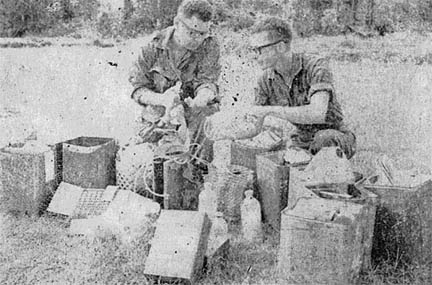 |
UNWITTING HELP - Specialists Five Dennis Ortman, of Cleveland, Ohio (l.), and Gerald Snyder, of Walla Walla, Wash., both medics for 2nd Battalion, 27th Infantry, examine medical supplies taken from a camouflaged Viet Cong hospital during operation Wahiawa. The drugs, which came from both Free World and Iron Curtain countries, included several types of antibiotics, blood plasma, dextrose and aspirin. A microscope, stethoscope and surgical instruments also were found. (Photo by Hirsh) |
In Opn. Wahiawa
Medics Perform As Heroes
Above the entrance to the 25th “Tropic Lightning” Division’s medical clearing
station hangs this sign: “Through these doors pass the finest soldiers in the
world; wounded only physically, still morally sound.”
This maxim was proven time and time again during operation Wahiawa, when
battalion-sized elements of the division’s second brigade maneuvered through the
Boi Loi Woods. Working through woods and jungle so dense that a man walking
five feet to the front was invisible, the 2nd Battalion, 27th Infantry ran into
trouble. Before they knew it, they were stopped by three VC machine guns hidden
in World War II-type bunkers, with a small slit for firing.
Companies Band C fought against heavy odds. The enemy was dug in and able to
fight on his own terms.
Captain William H. Gavin, Fort Monroe, Va., Company C commanding officer,
emerging from the jungle after trying to evacuate casualties for more than an
hour, had nothing but praise for his men. “When I got up to assault those
machine guns,” he said, “every damn man in the company got up behind me.”
The machine guns repelled that charge. Then from the survivors came the
tales of individual heroism in the attempts to knock out the automatic weapons
that had the companies pinned down.
A wounded soldier said, “This guy grabbed two grenades and charged the
position by himself. He was hit, went down, got up again and threw the
grenades. He died only ten yards from the bunkers.”
Two more soldiers crawled in under heavy fire to retrieve his body.
Just as the infantryman is characterized by a particular kind of courage, so
are the medics. The Wolfhound battalion medical platoon, nicknamed “Monroe’s
Marauders” after the battalion surgeon, was moved forward from the field command
post to the battle area to assist with the casualties.
Four medics grabbed litters and went out with the security and reconnaissance
platoons to evacuate casualties.
One of them has been nominated for the Bronze Star Medal for his performance
under fire. He began life-saving intravenous dextran injections on three men
while the group was surrounded by VC. Two other medics assigned to the line
companies have been nominated for the Silver Star Medal for their actions under
fire.
As soon as the wounded men came out of the woods, they were directed to the
aid station. There, medics attempted to patch up the line troops as well as
bolster their morale. One seriously wounded man was being carried on a litter
to a waiting helicopter. As he was brought past the aid station, a man stood
up, ran over to his side and grabbed his hand.
“Don’t worry about a thing, George,” said the man choking back a sob as he
looked at his buddy, “I’ll mail your letter for you. You’re gonna be all
right.” Then he turned away, tears in his eyes. The man was a platoon medic
for C Company. He, himself, had been hit in the leg, but he came out of the
woods straining under the weight of a litter bearing a more seriously wounded
comrade.
Even before the “Wolfhounds” reached the hospital they had adopted the motto,
“Wounded only physically, still morally sound.”
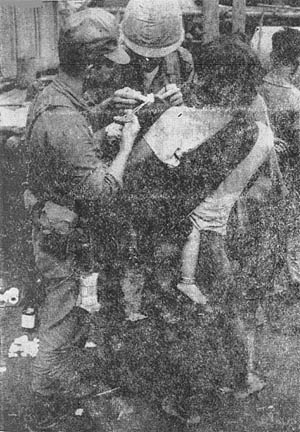 |
HEALING THE SICK - Second Lieutenant Hugh Harris (center), a member of the medical team of Headquarters and Headquarters Company, 2nd Battalion, 35th Infantry, treats a Montagnard baby of the village of Plei Ea La, southwest of Pleiku. This village was the first civic action site for the battalion on operation Paul Revere. Lieutenant Harris is assisted by an ARVN medic. (Photo by Sutphin) |
2ND BDE. OPENS CLIP JOINT
The “hairy” experiences of combat and life in the field have been eliminated
by the men of 1st Battalion (Mechanized), 5th Infantry.
Anticipating a lack of skilled barbers, C Company did some planning. Before
departing from Schofield Barracks, Hawaii, Co. C used unit funds to buy barber
equipment for each platoon. At the same time they drafted those in the unit who
had previous professional experience - and even some who didn’t.
Now, according to the men of the company, the barbers are doing a good job,
even the second stringers who pinch-cut for the number one barbers on rest and
recuperation trips.
Sergeant Ruben Perkins, of Nashville, Tenn., who carries his share of the
load in the field, immediately goes to work when he returns to base camp. One
day he says he worked five straight hours, giving nearly 30 haircuts.
“I haven’t received any complaints yet,” he said.
While the barbers may have a lot of fun, they don’t make much money. All
haircuts, alas, are free.
Books Become Friendly Companions In Field
What does an American soldier do when he has a few minutes to relax? Usually
one of two things. Write letters or read.
Paperback books have become as much a part of the war as food, ammunition and
cigarettes.
Even during the fierce fighting on operation Wahiawa in the Boi Loi Woods,
members of 2nd Brigade searched for a book to get them momentarily away from the
harsh realities of war.
When a sniper’s round cuts through a battalion base camp, an element of the
combat battalion is sent out to get the sniper, or artillery fire is called in on
the enemy. The other soldiers can only wait, poring over books that have been
passed around until the covers have fallen off from almost continuous use.
In helicopters supporting the brigade from the air, it is not unusual to see
a young private with a James Bond novel tucked into his flak jacket.
As one officer observed, “It is good that the waiting time present in any war
can be used to some advantage and good also that it momentarily takes your mind
off combat.”
Page 4 TROPIC LIGHTNING NEWS June 3, 1966
1st and 2nd Brigades
|
125th Sig. Bn. |
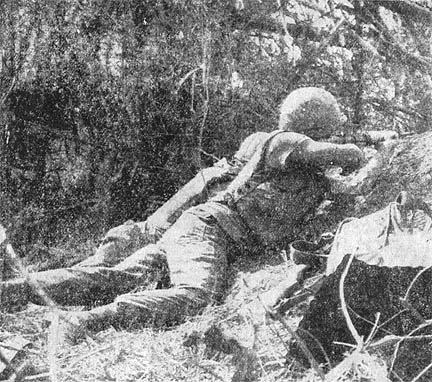 |
ATTACK! - Members of Company B, 4th Battalion, 23rd Infantry, fire at Viet Cong. |
| DUG IN – Soldiers from B Company, 27th Infantry, investigate a Viet Cong tunnel. |
 |
 |
PAUSE THAT REFRESHES - A “Tropic Lightning” soldier pauses to eat a pineapple he picked to the jungle. |
| ASSEMBLY – Viet Cong suspects are taken to the rear for questioning. |
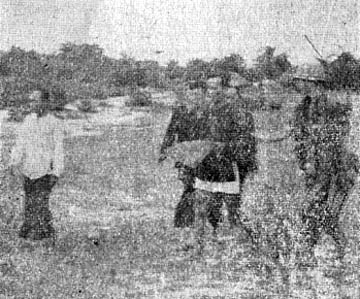 |
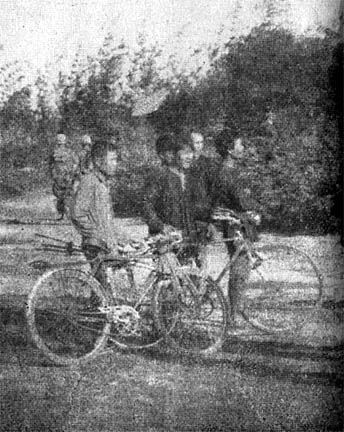 |
Detainees |
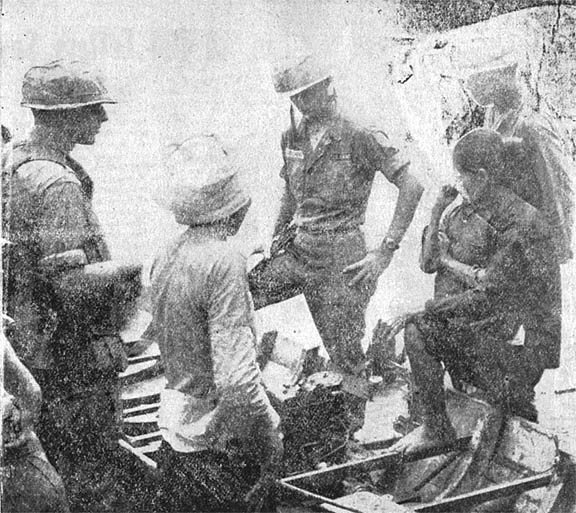 |
| WATER TRAFFIC – A motor launch on the Oriental River is inspected by men of B Company, 2nd Battalion, 27th Infantry. |
Page 6 TROPIC LIGHTNING NEWS June 3, 1966
It was a war between the North and the South. The Yankees were in southern
territory, moving south. It was a painstakingly slow march. It had to be: the
Yankees were leaving behind them nothing of use to the enemy. Scorched earth
was their policy. Houses, huts, grain and ammunition stores were leveled.
The march was strikingly similar to Sherman’s March to the Sea in the
American Civil War. In reality, it was operation Wahiawa.
The 4th Battalion, 23rd Infantry, on a typical day of the operation, was
moving south through the Ho Bo Woods sector of Quan Cu Chi District. Ho Bo
Woods got its name from the Ho Bo rubber plantation in the midst of the area.
The mission was to search, clear and destroy the entire area . . . a
stronghold of the Viet Cong. The battalion spread out over the previous night’s
campground, a rice paddy 250 yards wide. Every time a tunnel or hut was
discovered, the battalion halted for the demolition men to destroy it. For two
hours the men inched their way across the field.
Company B was in the lead, and it was up to their commander to decide what to
do. Captain Ronald C. Becker called the march to a halt after discovering a
small village in the woodline. He felt that to destroy the village and its vast
network of tunnels would take the rest of the day.
Lieutenant Colonel Michael Barszcz, battalion commander, remarked that he
felt the operation was an investment in future results. The local civilian
population had fled the area and the Viet Cong now had to do his own work. He
felt that time would tell the strain put on “Charlie” by forcing him to re-dig
his tunnels alone and forcing him to farm his own food.
One of the civilians questioned the day before had told an interpreter that
the sniper fire being received was just the crazy kids in the village who liked
to shoot a rifle. The colonel scoffed when told of this. He laughed and said
the crazy kid sure did get around - he was firing from three different places at
once!
As nightfall came the day’s statistics were compiled. The VC had apparently
decided to abandon their bases as there were no confirmed Viet Cong kills.
Three bunkers and 19 tunnels and holes had been blown up, along with 15 houses.
The men, faced with transportation difficulties, had to destroy 9,000 pounds of
rice, 400 pounds of peanuts, 400 pounds of fertilizer and smaller amounts of the
commodities.
“Charlie” will undoubtedly come back to Ho Bo Woods. When he returns he will
be far less effective. His bases are no more. He will be required to take
extra time . . . time away from fighting and terrorizing . . . to rebuild and
restock.
Just when his rebuilding is completed word will come from his observation
posts that the U.S. government forces are coming again. Will he stay and defend
his area this time, or will he again retreat into the jungle?
Tan An Hoi Letters Say Thanks
It isn’t all hard, thankless fighting. Occasionally, someone says “Thanks.”
Major General Fred C. Weyand, division commander, recently received two
thank-you notes from the people of Tan An Hoi village located near the “Tropic
Lightning” base camp at Cu Chi.
The first letter came from Mr. Ngo Xuan Truong, the administrative committee
chairman of Tan An Hoi village, while the other was from Mr. Le Van Sac, a
representative for the people living in Tan An Hoi village.
Mr. Ngo’s letter starts, “We respectfully express our thankfulness to all of
the officers, NCOs and enlisted men and their families in Hawaii, and wish for
their best health.”
“Formerly Cu Chi District was desolate and like a desert due to Viet Cong
pressure. Mortar shells and sabotage made the life and activities of the people
insecure.”
“My people’s standard of living has returned to normal. The local
inhabitants and neighbors have been able to open new shops. A happy scene has
returned to our village because of the power of the U.S. forces stationed here.
They have rescued this area from Viet Cong pressure. Moreover, the U S. forces’
victory has restored security for my people and we believe in the U.S. forces.”
“ The Americans have helped us to triumph over communist aggression, poverty
and disease. These actions were accomplished through the activities of the
“Civil Affairs” team of the 25th Infantry Division, by the families in the
United States who have sent their sons to fight in Vietnam and by the gifts from
Hawaii donated to our people.”
He concluded, “Once more, we wish the major general and all of the soldiers
to have good luck and to triumph over the communists in order to make the
Vietnamese government stronger - the aspiration of your government and people of
your country.”
Mr. Le’s letter says, “On behalf of the population of Tan An Hoi village, Cu
Chi District, Hau Nghia Province, we sincerely express our gratitude to you.”
“Since the arrival of your troops in Vietnam, the VC and the National
Liberation Front of South Vietnam have suffered many defeats. In Cu Chi
District, especially in the village of Tan An Hoi, with the presence of the 25th
Infantry Division, the communists can no longer destroy houses by mortar
shelling, and kill people with mines and grenades.”
“No longer frightened and worried for their own lives, the population came
back to their houses, and the deserted marketplace is now a busy, crowded
place. We are very grateful to you for the gifts (clothes, food) sent by the
people of Hawaii. Your MEDCAP (Medical Civic Action Program) teams go to every
hamlet taking care of the population’s health and distributing medicines to our
people.”
“We will never forget what you have done for us. We pledge to cooperate with
your forces to fight and annihilate all the VC so that our country can soon
achieve its independence and unity.”
Mr. Le concludes with, “We pray that God bless you and all Americans, our
friend who are sacrificing for our people and country.”
2 1/2 Minutes to Better Bridge
“The armored vehicle launched bridge is similar to a Volkswagen,” Sergeant
Bernard Restrepo, of Company E, 65th Engineer Battalion, said recently. “The
engine is in the rear and it’s air-cooled.”
That’s just about where the similarity ends.
The bridge weighs 128,420 pounds (give or take a few ounces), is more than 63
feet long, takes 2,000 pounds of pressure per square inch to lift it and is
moved by an 825-horsepower engine mounted in an M-48 tank.
It also costs $160,000, slightly more than a Volkswagen, even the deluxe
model with a sundeck roof.
Sgt. Restrepo, of Bogota, Colombia, said that the portable bridge is designed
primarily to replace damaged or destroyed bridges in the path of a troop
movement or to make a bridge where none exists.
Under ideal conditions, the hydraulic system will scissor the bridge out in
less than two and a half minutes. It will span up to 60 feet and support any
vehicle the Army now maintains with a maximum load of 60 tons.
With the 825-horsepower, fuel-injected engine (more than one horsepower for
every five pounds of engine) and its mammoth size, it’s doubtful anyone will
ever call it a “beetle.”
| INSTANT BRIDGE - Sergeant Bernard Restrepo of 65th Eng. Bn., appears quite insignificant beside the mammoth-size armor vehicle launching bridge. (Photo by Hanson) |
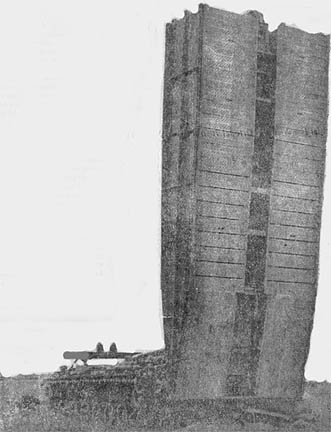 |
SOUTH POLE DUTY TO BE 130° BELOW
U.S. has established a new Antarctic station at what is believed to be the
coldest spot on earth, where temperatures may fall to 130 degrees Fahrenheit or
more below zero. It is expected lowest temperature will be recorded during
forthcoming winter, probably around July 4, Douglas Elvers, geophysicist with
Environmental Science Services, said. Coldest previously recorded in Antarctica
by U.S. was minus 113 degrees Fahrenheit on July 21, 1965.
Peeping “Beep Beep” Named Cheep Mascot
As Staff Sergeant Charles K. Stoliker talked to his men, a faint peeping
sound came from somewhere. He was saying, “...I killed three and captured
one…” Then the sergeant reached in his ammunition pouch and produced the source
of the peeping . . . the lone survivor of Stoliker’s combat adventure.
It was a baby chick named “Beep Beep.” The sergeant said Beep Beep was “too
young to know what the fighting was all about.” For that reason he was spared.
The men had some good fresh chicken that night as they fried the legs of the
other three chickens over a camp fire.
It was all part of operation Wahiawa, conducted by the 25th Infantry Division
in Quan Cu Chi District, the Republic of Vietnam. The object was to search,
clear and destroy Viet Cong forces and fortifications in an area 35 miles
northwest of Saigon.
Sgt. Stoliker, a squad leader with B Company, 4th Battalion, 23rd Infantry,
says Beep Beep, now that the operation is over, will become the squad’s mascot.
Page 7 TROPIC LIGHTNING NEWS June 3, 1966
COMMUNICATIONS PLAY BIG PART IN SECOND BRIGADE OPERATIONS
“I thought the wires led back to base camp...”
“No,” corrected Major Clyde Merrick, of Maynard, Mass. “If our
communications depended on wires going as far as Cu Chi, for example, the Viet
Cong would be able to cut or tap our lines.
“I’m using two, 12-line switchboards, to which all of our phones are
connected by wire,” observed the 2nd Brigade signal officer, the man responsible
for the “Fire Brigade’s” communications.
In his vital position, the major pointed out that the only wire his unit uses
is to the telephone switchboard. “From there the conversation is relayed by VHF
radio to a receiver at the distant end. That receiver is, in turn, connected to
another switchboard, such as the one back at base camp.”
Under most conditions, radio equipment can be placed 25 miles apart. “This,
of course,” said Maj. Merrick, “depends upon the frequency, the height of the
antenna and, most important, the terrain.
“Frequently, a natural obstruction, such as a mountain, will stop a signal at
close distances. But sometimes we experience a phenomenon known as obstacle
gain, which means simply that the radio waves bounce off an object. When the
waves ‘splatter,’ the receiving station is able to pick up the signal, sometimes
much stronger than if it had not been bounced.”
Complicating Maj. Merrick’s technical work are the different types of lines
that are set up in the field: “common user,” “hot” and teletype lines. Common
user lines are for ordinary telephone communications, available to everyone on a
first-come, first-serve basis. The hot lines, usually available to the
operations, artillery and aviation officers, are, the major said, “for the use
of important staff sections, so they can have immediate contact with base camp
and not have to wait in the event the common lines are busy.”
Teletype lines, meanwhile, operate independently, offering an immediate,
written record between transmission and receiving points. The sender types his
message to be received on the other end by a teletype machine in the same form.
Unfortunately, with only one exception, Maj. Merrick’s communications lines
are not secure.
“That exception,” he explained, “is the teletype line having a crypto machine
on each end. When this is the case, the transmission between the two machines
is garbled and in unintelligible. Turning it back into understandable English
is the job of a decoding device on the receiving end. For security purposes,
the code is changed frequently.”
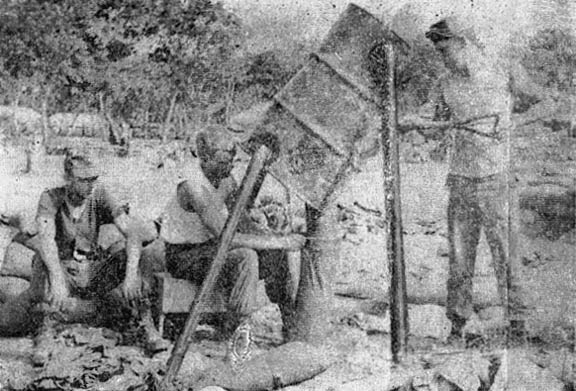 |
| MACHINE AGE – There are always two ways to do a job: an easy way and a hard way. Where soldiers are concerned, they’ll take the former. These three men from the mortar platoon of the 1st Battalion, 27th Infantry, were given the task of filling enough sandbags to build a bunker around their mortar emplacement. With the aid of an ingenious Headquarters Company maintenance section, PFC Larry W. Perry, 19, of Columbia, Ala., can shovel sand into the bags held by Private Larry D. McGaughey, 20, of Milan, Mo., at a pace unheard of prior to “sandbag machines.” Private Charles L. Emery, 20, of Baltimore, Md., waits to tie one of the 300 bags that come off the assembly line each hour. Before automation - an empty artillery cannister and a 55-gallon drum on legs - only 100 bags an hour were filled. (Photo by Hanson) |
Medics Get False Alarm; Viet Cong Gets Last Ride
“I was out on a listening post,” said Sergeant Ralph Sams, of Rome, Ga.,
“when I heard Viet Cong approaching my position.”
“I caught sight of two of them. They were half-walking, half-crawling and
both of them were carrying Red Chinese rifles. I figured they were going in to
the edge of the tree line to snipe at the command post,” said the 2nd Battalion,
27th Infantry, recon platoon sergeant.
Sgt. Sams said, “The jungle was so thick they came within ten feet of me
before I could see them very well, then I opened up with my M-16. They returned
the fire. I hit one and he dropped. The other one had retreated into the
undergrowth as soon as I fired the first round.
I yelled “I got him” but somebody didn’t understand me. All of a sudden
everyone was yelling for a medic and about half a dozen guys came running to my
position. One of them had a litter. 1 suppose it was meant for me - but we put
‘Charlie’ on it and carried him up to the command post.”
The VC was carrying four Chinese hand grenades, a bayonet-fitted 7.62mm rifle
and ammunition, and wearing web gear. Blood was found where the other VC had
been, but no trace of the wounded man was found.
Modern Wagon Train Carries Goods
The command, “Head ‘em up and move’em out,” set more than a thousand men and
thousands of tons of equipment into motion as they left 2nd Brigade’s base camp
to a position just south of a Viet Cong stronghold, the Boi Loi Woods.
The object was to set up a forward base camp to support three combat
battalions of the brigade while they were engaged in operation Wahiawa, the
largest operation the division has conducted in Vietnam.
It wasn’t an easy task, the moving of tanks, armored personnel carriers and
more than 300 vehicles down muddy roads. Rations had to be taken. Two thousand
gallons of JP-4 fuel were needed for the helicopters, while the jeeps and
lighter trucks had to have 1,500 gallons of gasoline to keep them running.
Another 800 gallons of diesel fuel were needed to quench the thirst of heavy
trucks and tanks.
The big guns from 1st Battalion, 8th Artillery, moved to the field, followed
initially by 300 helilifted howitzer rounds. A thousand more were needed later
and, the following day, a convoy, groaning under the strain of an additional
4,800 rounds, brought in more firepower to support the infantry battalions.
Helicopters, cutting through their own dust clouds, began resupply missions
to the battalions and the mercy flights of medical evacuation.
A special landing site was setup to accommodate “dustoff” choppers, which
touched down just a few feet from the forward aid station. All wounded were
taken into this area, where doctors offered treatment within minutes after the
men were evacuated from the fighting.
Amid the feverish activity of digging foxholes and setting up tents,
signalmen labored to erect the huge communications antenna, the brigade’s
lifeline which coordinated the operation’s command networks.
The four separate convoys managed to push through to the brigade command
post, in spite of mud fouling and mines. And Viet Cong sniper fire was
omnipresent, competing with incoming helicopters for air space. Machine gun
fire from 3rd Squadron, 4th Cavalry, and heavy artillery barrages quickly
knocked out the enemy positions.
The base camp was secure.
2/35TH TACKLES TWO JOBS
Members of the 3rd Brigade, on operation Paul Revere, recently turned a
search-and-destroy mission into constructive effort for friendly Montagnards.
On May 18, elements of Company B, 2nd Battalion, 35th Infantry, were
helilifted on a search-and-destroy mission a few miles from the brigade’s base
camp.
At 7:30 a.m., nine choppers waited at the landing strip to take an estimated
55 men to the village of Plei Kla, a relatively short distance away.
Shortly after the helicopters landed, the members of the “Tropic Lightning”
Division moved into action. The company encircled the village and search
parties rounded up the 350 Montagnard inhabitants. Then came the task of
searching for enemy weapons and supplies.
The search party moved swiftly through the huts, combing every inch, but
found nothing. Their mission then became one of winning the support of the
government cause. A sick call was conducted by Captain Alford Tabatsky,
battalion surgeon.
As Capt. Tabatsky treated the women for goiters and the children for lack of
vitamins, the men of 2/35th passed out cigarettes to the adults and candy to the
children.
A helicopter landed on the outskirts of the village and the men began
outfitting the tribesmen with supplies contributed in the division’s Operation
“Helping Hand.”
A tribal tradition stopped the Montagnard, from removing their own clothing,
but they were only too delighted to wear the colorful gifts over it.
Lightning Bug Chases Viet Cong River Traffic
The “Tropic Lightning” Division is now lighting up the sky with 1,750,000
candles in an attempt to halt the flow of Viet Cong and VC material on the
waterways of South Vietnam.
Major Ronald C. Bines, gunship section leader of Company B, 25th Aviation
Battalion, and the man primarily responsible for the “Lightning Bug” project,
points out, “We can sink river traffic on a moonless night within two minutes
after spotting it, using the ‘Lightning Bug.’
“Lightning Bug” is the name of a “combined arms” team of three UH-1B
helicopters, carrying weapons, flares and bright lights. The light ship has
seven C-130 aircraft landing lights mounted on an adjustable frame on the ship’s
side. One of the gunners doubles as the light operator.
The team’s job is to stop river traffic. As the light sweeps along the
water, most of it is reflected back. The water looks silvery. When the light hits a sampan or
some other major obstruction, it doesn’t reflect the light back. The object
appears as a dark shape in sharp contrast against the silvery water.
Now the need for even more light has been established and one of the other
ships fires a flare which provides 1.75 million candlepower. Then the gunship
comes in and the Viet Cong are destroyed. Among the three ships is a
devastating combination of 7.62mm machine guns, 2.75 inch aerial rockets, .50
caliber machine guns and 40mm grenade launchers.
Major James R. Vance, B Company commander, is particularly proud of his men
and their skill in operating this new addition to his company’s equipment.
Almost all the men of his unit are involved in operational training to work in
coordination with the “Lightning Bug” team.
Page 8 TROPIC LIGHTNING NEWS June 3, 1966
 |
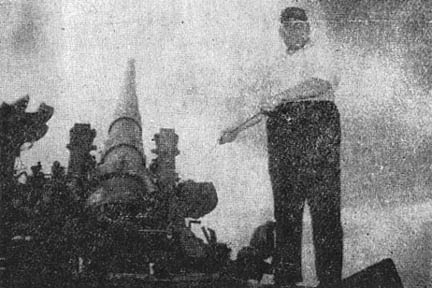 |
| ON THE VOCAL - Mary Petite sings while the Big “Tiny” Little Band swings at a recent performance for division troops at the division amphitheater. | TRYOUT - Big “Tiny” Little pulls the lanyard of a 175mm howitzer during a tour of the 2nd Battalion, 32nd Artillery. |
Little Makes It Big At Cu Chi
By PFC Lou Cullen
The whole stage was rocking to the lively beat. The men in the audience were
cheering, clapping, and stamping their feet to the rhythm. Big “Tiny” Little
was at the keyboard, Mary Petite at the mike, and the rest of the band was right
in tune. It was show time once again at Cu Chi.
Big “Tiny” and his versatile group staged two performances for “Tropic
Lightning” troops at the division amphitheater.
Mary Petite, a dynamic and shapely vocalist, was one of the featured
attractions of the show.
From the opening number, “A Taste of Honey,” to the end of the show, when
Miss Petite invited volunteers to come on stage to dance with her, the show was
a hit.
One of the troops’ favorite numbers was “Sing, Sing, Sing,” a tune which
recalled memories of the Gene Krupa-Benny Goodman era.
Featured in this number were Dick Lopez on the drums and Glenn Blair on the
sax and clarinet.
Between performances of the show, Little and his band were given a tour of
the 2nd Battalion, 32nd Artillery, area. At the site of the “Alligator,” a
175mm self-propelled gun, a special class was held for the “Little Group.”
After the briefing Big “Tiny” was given a chance to try his hand at setting
the gun on target. He also got the feel of pulling the lanyard that sets off
the charge. To everyone’s relief, there was no shell in the tube.
Nosey U.S. Soldiers Delay Grand Opening
Company C, 1st Battalion, 27th Infantry, feted the Viet Cong with a grand
opening to the enemy’s new rice storage complex during operation Wahiawa – two
months early. When the company found the partially completed installation deep in the heart
of the Boi Loi Woods, they uncovered more than 239 tons of rice and the
beginning of an intricate defense system.
The camp was ringed with empty foxholes, the first phase of a large defense
perimeter. The area was camouflaged and ambush sites had been staked out.
C Company Commander Captain Ardeen Foss, of Sioux Falls, S.D., said that the
company would have found the opening somewhat less than grand had it stumbled
across the complex just two months later.
As it was, the advancing troops met light resistance and found the complex
empty, although speculation had it that a Viet Cong work force had fled after
being surprised by the Americans.
The company, in searching the area, discovered two parallel trails, 100 yards
apart. On each side of the trail, the VC appeared to have had between 12 and 18
warehouses in the planning stage.
The four completed warehouses had their 15-by-25-foot storage space filled
with rice. Built on a log cabin base and a sloping, tin roof, the warehouses
were set about nine feet off the ground.
And waiting in the wings was the rest of the rice, stacked on long logs in
100-pound bags, 60 to 80 bags high. The company also found 100 bales of tin,
each containing 25 sheets, and 1,700 pounds of peanuts.
Grand opening delayed due to curious Americans.
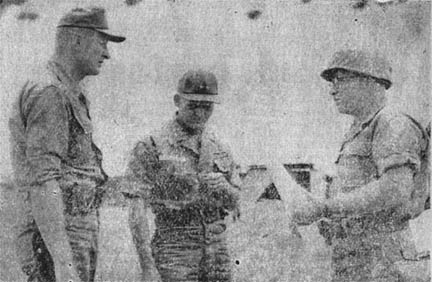 |
Major General John C. F. Tillson, III (center), MACV J-3, discusses operation Wahiawa with Major General Fred C. Weyand (left), division commanding general, and Colonel Thomas M. Tarpley, commanding officer of 2nd Brigade. (Photo by Hanson) |
Rain, Glop Make War Worse
War, at its best, is far from pleasant; but there is one ingredient that can
make it better or worse: the weather.
In Vietnam, the weather usually makes it worse. Heat and humidity become
oppressive and one wonders how bad the weather can get. “Cheer up”, someone
says, “things could be worse.” You cheer up and things do get worse: the
monsoon season comes.
As in the salt ad, “when it rains it pours.” The quantity and frequency of
H2O from on high has to be seen, or felt, if you will, to be believed.
All around Vietnam, but especially in and near Pleiku, one of the by-products
of this downpour is mud. Mud in Vietnam, like many other things, however, is
unlike mud anywhere also. It is slimier, mushier, sloppier, and more difficult
to maneuver in than plain, old Stateside mud.
To the old adage, “War is hell!” might be added, “so is mud.”
Thanks to:
The 25th Infantry Division Museum for providing the volume of 1966 Tropic
Lightning News,
Ron Leonard, 25th Aviation Battalion for finding and mailing them,
Kirk Ramsey, 2nd Bn., 14th Inf. for creating this page.
This page last modified 09-22-2006
©2006 25th Infantry Division Association. All rights reserved.